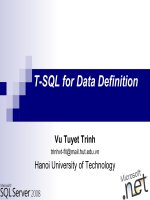SQL Server - Bài 12
Bạn đang xem bản rút gọn của tài liệu. Xem và tải ngay bản đầy đủ của tài liệu tại đây (1.27 MB, 53 trang )
Optimizing
Query Performance
Vu Tuyet Trinh
Hanoi University of Technology
1
MicrosoftMicrosoft
Overview of Query Processing
Parsing Process
Standardization Process
Query Optimization
Compilation
Database Access Routines
Transact-SQL
Results
Set
MicrosoftMicrosoft
Outline
Introduction to Query Optimizer
Obtaining Execution Plan Information
Using an Index to Cover a Query
Indexing Strategies
Overriding the Query Optimizer
Database Tuning Advisor
MicrosoftMicrosoft
Query Optimizer Issues
Function
Cost-Based Optimization
How It Works
Phases
Caching the Execution Plan
Setting a Cost Limit
MicrosoftMicrosoft
Cost-Based Optimization
Limits the Number of Optimization Plans to Optimize in
Reasonable Amount of Time
Cost is estimated in terms of I/O and CPU cost
Determines Query Processing Time
Use of physical operators and sequence of operations
Use of parallel and serial processing
•
To reduce the number of rows returned.
•
To reduce the number of pages read.
•
To reduce the overall processing time.
MicrosoftMicrosoft
Query Optimization Phases
Query Analysis
Identifies the search and join criteria of the query. By limiting
the search, the query optimizer minimizes the number of rows
that are
processed
Index Selection
Determines whether an index or indexes exist. Then, there is
an assessment of the usefulness of the index or indexes.
Usefulness of an index is determined by how many rows will
be returned
Assesses the usefulness of the index or indexes
Join Selection
Evaluates which join strategy to use by considering a number
of factors: selectivity, density, memory required to process the
query.
MicrosoftMicrosoft
Caching the Execution Plan
Storing a Execution Plan in Memory
One copy for all serial executions
Another copy for all parallel executions
Using an Execution Context
An existing execution plan is reused, if one exists
A new execution plan is generated, if one does not exist
Recompiling Execution Plans
Changes can cause execution plan to be inefficient or invalid
For example, a large number of new rows added
ALTER TABLE/VIEW
UPDATE STATISTICS
Dropping an INDEX that is used
Explicit sp_recompile
MicrosoftMicrosoft
Setting a Cost Limit
Specifying an Upper Limit (based on Estimated Costs)
Use the query governor to prevent long-running queries from
executing and consuming system resources
Effectively controls run-away queries
Specifying Connection Limits
Use the sp_configure stored procedure
Execute the SET QUERY_GOVERNOR_COST_LIMIT statement
Specify 0 to turn off the query governor
MicrosoftMicrosoft
Obtaining Execution Plan Information
Viewing STATISTICS Statements Output
Viewing SHOWPLAN_ALL and SHOWPLAN_TEXT Output
Graphically Viewing the Execution Plan
MicrosoftMicrosoft
STATISTICS Statements Output
Statement
Statement
Output Sample
Output Sample
STATISTICS
TIME
STATISTICS
PROFILE
STATISTICS IO
SQL Server Execution Times:
CPU time = 0 ms, elapsed time = 2 ms.
Rows Executes StmtText StmtId…
-----------------------------------------------
47 1 SELECT * FROM [charge] 16
WHERE (([charge_amt]>=@1)
.
.
.
Table 'member'. Scan count 1,
logical reads 23, physical reads 0,
read-ahead reads 0.
MicrosoftMicrosoft
STATISTICS TIME obtains information about
the number of milliseconds required to parse,
compile, and execute each statement.
STATISTICS PROFILE displays the profile
information for a statement.
STATISTICS IO obtains information about the
amount of page reads generated by queries.
MicrosoftMicrosoft
SHOWPLAN_ALL and
SHOWPLAN_TEXT Output
Structure of the SHOWPLAN Statement Output
Returns information as a set of rows
Forms a hierarchical tree
Represents steps taken by the query optimizer
Shows estimated values of how a query was optimized, not the actual
execution plan
Details of the Execution Steps
* Which indexes are used with which tables
* The join order of the tables
* The chosen update mode
* Worktables and other strategies
Explore:
What is the difference Between SHOWPLAN_TEXT and
SHOWPLAN_ALL Output
MicrosoftMicrosoft
Graphically Viewing the Execution Plan
Elements of the Graphical Execution Plan
Reading the Graphical Execution Plan Output
Using the Bookmark Lookup Operation
MicrosoftMicrosoft
Elements of the Graphical Execution
Plan
Steps Are Units of Work to Process a Query
Sequence of Steps Is the Order in Which the Steps Are
Processed
Logical Operators Describe Relational Algebraic Operation
Used to Process a Statement
Physical Operators Describe Physical Implementation
Algorithm Used to Process a Statement
MicrosoftMicrosoft
Bookmark Lookup
Filter
Hash Match
Index Scan
Index Seek
Merge Join
Nested Loops
Sort
Table Scan
A partial list of physical operators
MicrosoftMicrosoft
Reading Graphical Execution Plan Output
Query Plan
SELECT
Cost: 0%
Bookmark Lookup
Cost: 8%
Hash Match Root…
Cost 28%
Member.corp_no
Cost 9%
Member.fname
Cost: 10%
Filter
Cost: 0%
Sequence of Steps
Sequence of Steps
Index Seek
Scanning a particular range of rows from a non-
clustered index.
Physical operation:
Logical operation:
Row count:
Estimated row sizes:
I/O cost:
CPU cost:
Number of executes:
Cost:
Subtree cost:
Index Seek
Index Seek
414
24
0.00706
0.000605
1.0
0.007675(6%)
0.00767
Argument:
OBJECT: ([credit].[dbo].[member].[fname]),
SEEK: ([member],[firstname] >=‘Rb’ AND
[member],[firstname] <‘T’) ORDERED
MicrosoftMicrosoft
Using the Bookmark Lookup Operation
Analyzing the Query Plan
Typically used after all steps have been processed
Retrieving Rows
Row identifiers to find the corresponding row in a
heap.
Clustering Keys to find the corresponding row in a
clustered index
Observing the Details
A bookmark label used to find the row in the table or
clustered index
The table name or clustered index name from which the
row is found
The WITH PREFETCH clause, if the query optimizer
determines that readahead is the best way to find
bookmarks in the table or clustered index
Determining When the Bookmark Lookup Operator is Used
Queries containing the IN clause or the OR operator
MicrosoftMicrosoft
Using an Index to Cover a Query
Covering a Query: Resolving Queries without accessing
the data pages
Introduction to Indexes
Locating Data by Using Indexes
Identifying Whether an Index Can Be Used
Determining Whether an Index Is Used
Guidelines for Creating Indexes
MicrosoftMicrosoft
Introduction to Indexes That Cover a
Query
Indexes That Cover Queries Retrieve Data Quickly
Only Nonclustered Indexes Cover Queries
Indexes Must Contain All Columns Referenced in the
Query
No Data Page Access Is Required
Indexed Views Can Pre-Aggregate Data
MicrosoftMicrosoft
Locating Data by Using Indexes That
Cover a Query
Example of Single Page Navigation
Example of Partial Scan Navigation
Example of Full Scan Navigation
MicrosoftMicrosoft
Example of Single Page Navigation
Index Pages
Non-Leaf
Level
Leaf Level
(Key Value)
SELECT lastname, firstname
FROM member
WHERE lastname = 'Hall'
Akhtar
Barr
Barr
Borm
Buhl
Sarah
…
…
…
…
Ganio
Hall
Hart
Jones
Jones
Jon
Don
Sherri
Amy
Beverly
Hall Don
Lang
Martin
Martin
Martin
Moris
Eric
…
…
…
…
…
Data Pages
… …
Akhtar
Lang
…
…
Sarah
Eric
…
…
Akhtar
…
Ganio
…
Sarah
…
Jon
…
Lang
…
…
…
Eric
…
…
…
MicrosoftMicrosoft
SQL Server goes through the following steps to
retrieve the information:
1. Traverses the index tree comparing the last name
Hall to the key values.
2. Continues to traverse the index until it reaches the
first page of the leaf level containing the key value
Hall.
3. Returns the qualifying rows without accessing the
data pages, because the lastname and firstname key
values are contained in the leaf level.
MicrosoftMicrosoft
Example of Partial Scan Navigation
Index Pages
Non-Leaf
Level
Leaf Level
(Key Value)
Akhtar
Barr
Barr
Borm
Buhl
…
…
…
…
…
Ganio
Hall
Hart
Jones
Jones
…
…
…
…
…
Morgan
Nash
Nay
Ota
Rudd
…
…
…
…
…
Chai
Con
Con
Cox
Dale
…
…
…
…
…
Dunn
Dunn
Fine
Fort
Funk
…
…
…
…
…
Jordan
Kim
Kim
Koch
Koch
…
…
…
…
…
Lang
Martin
Martin
Martin
Moris
…
…
…
…
…
Smith
Smith
Smith
Smith
Smith
…
…
…
…
…
Data Pages
USE credit
SELECT lastname, firstname
FROM member
WHERE lastname BETWEEN 'Funk' AND 'Lang'
Akhtar
Chai
Dunn
Ganio
…
…
…
…
Jordan
Lang
Morgan
Smith
…
…
…
…
Akhtar
Jordan
…
…
…
…
MicrosoftMicrosoft
SQL Server goes through the following steps
to retrieve the information:
1. Traverses the index tree.
2. Starts reading leaf-level pages at the page
that contains the first occurrence of the last
name Funk. Data in the leaf level is sorted in
ascending order.
3. Reads the range of leaf-level pages through
to the last name of Lang. At this time, the
partial scan is completed.
4. Returns the qualifying rows without
accessing the data pages, because the leaf
level is scanned for last names between Funk
and Lang
MicrosoftMicrosoft
Example of Full Scan Navigation
Index Pages
Non-Leaf
Level
Leaf Level
(Key Value)
Akhtar
Barr
Barr
Borm
Buhl
…
…
…
…
…
Ganio
Hall
Hart
Jones
Jones
…
…
…
…
…
Morgan
Nash
Nay
Ota
Rudd
…
…
…
…
…
Martin
Smith
…
Akhtar
Ganio
…
Akhtar
…
Martin
Chai
Con
Con
Cox
Dale
…
…
…
…
…
Dunn
Dunn
Fine
Fort
Funk
…
…
…
…
…
Jordan
Kim
Kim
Koch
Koch
…
…
…
…
…
Lang
Martin
Martin
Martin
Moris
…
…
…
…
…
Smith
Smith
Smith
Smith
Smith
…
…
…
…
…
…
Data Pages
USE credit
SELECT lastname, firstname
FROM member









